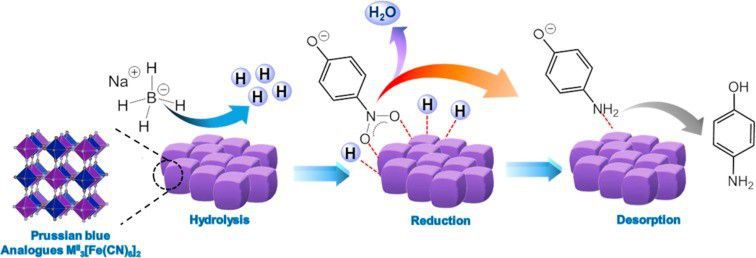| 論文篇名 | 英文:A Comparative Study of Hexacyanoferrate-based Prussian Blue Analogue Nanocrystals for Catalytic Reduction of 4-Nitrophenol to 4-Aminophenol 中文:基於六氰基高鐵酸鹽的普魯士藍類似物納米晶體對4-硝基苯酚催化還原成4-氨基苯酚的比較研究 |
| 期刊名稱 | Separation and Purification Technology |
| 發表年份,卷數,起迄頁數 | 2019, 218, 138-145 |
| 作者 | T Wi-Afedzi, FY Yeoh, MT Yang, ACK Yip, KYA Lin |
| DOI | 10.1016/j.seppur.2019.02.047 |
| 中文摘要 | 4-硝基苯酚(4-NP)的催化還原代表了將4-NP轉化為更環保的產品4-氨基苯酚(4-AP)的有用方法。普魯士藍(PB)(Fe3 [Fe(CN)6] 2)及其普魯士藍類似物(PBA)(MII [Fe(CN)6] PBA(MII = Mn,Co,Ni和Zn)表現出分層的多孔結構,以及電化學特性,使PBAs有望成為4-NP還原的催化劑,然而,很少有文獻報導使用PBAs將4-NP還原為4-AP,並且還沒有研究評估不同MII物種對PBAs的影響。 [Fe(CN)6] -PBAs對4-NP催化轉化成4-AP的催化作用本文中,我們研究了各種MII [Fe(CN)6] PBAs(MII = Co,Fe,Mn ,鎳和鋅),在硼氫化鈉(NaBH4)存在下,將4-NP還原為4-AP。PBA對4-NP還原的催化活性為CoFeCN> NiFeCN> FeFeCN> MnFeCN> ZnFeCN CoFeCN,NiFeCN,MnFeCN,FeFeCN和ZnFeCN的相應活化能分別確定為32、43、46、47和54 kJ / mol。速率常數為0.457 min-1且計算的周轉頻率為6.3×10-3-3ss-1的最強的催化活性,由於其高的表面積以及對生氫和加氫的催化活性,因此比許多報導的貴金屬催化劑要高。即使連續進行了6次還原實驗,CoFeCN(和NiFeCN)也具有出色的可重複使用性。這些發現表明,PBA,例如CoFeCN和NiFeCN,是用於還原4-NP的高度有利的催化劑,並且有望用於還原其他硝基-芳族化合物。 |
| 英文摘要 | Catalytic reduction of 4-nitrophenol (4-NP) represents a useful method of converting 4-NP into a more environmentally friendly product, 4-aminophenol (4-AP). Prussian blue (PB) (Fe3[Fe(CN)6]2) and its Prussian blue Analogues (PBAs) (MII[Fe(CN)6] PBAs (MII = Mn, Co, Ni, and Zn) exhibit hierarchical porous structures, and electrochemical characteristics, making PBAs promising catalysts for 4-NP reduction. Nevertheless, very few literatures report the reduction of 4-NP to 4-AP employing PBAs, and no studies have been ever conducted to evaluate the effects of different MII species of [Fe(CN)6]-based PBAs on the catalytic conversion of 4-NP to 4-AP. Herein, we examine the catalytic reductive performance of various MII[Fe(CN)6] PBAs (MII = Co, Fe, Mn, Ni, and Zn), in the presence of sodium borohydride (NaBH4), on 4-NP reduction to 4-AP. The catalytic activity of PBAs for 4-NP reduction was in the order CoFeCN > NiFeCN > FeFeCN > MnFeCN > ZnFeCN. The corresponding activation energies are determined as 32, 43, 46, 47, and 54 kJ/mol for CoFeCN, NiFeCN, MnFeCN, FeFeCN and ZnFeCN, respectively. Especially, CoFeCN shows the highest catalytic activity with a rate constant of 0.457 min−1 and a calculated turnover frequency of 6.3 × 10−3 s−1, which are higher than many reported noble metal catalysts because of its high surface area and catalytic activities towards hydrogen generation and hydrogenation. CoFeCN (and NiFeCN) also exhibit excellent reusabilities even after 6 consecutive reduction experiments. These findings demonstrate that PBAs, such as CoFeCN and NiFeCN, are highly advantageous catalysts for reduction of 4-NP and would be promising for reducing other nitro-aromatic compounds. |
A Comparative Study of Hexacyanoferrate-based Prussian Blue Analogue Nanocrystals for Catalytic Reduction of 4-Nitrophenol to 4-Aminophenol 2019-02-25

循環農業:農業廢棄物高價值化【環工系林坤儀教授】






